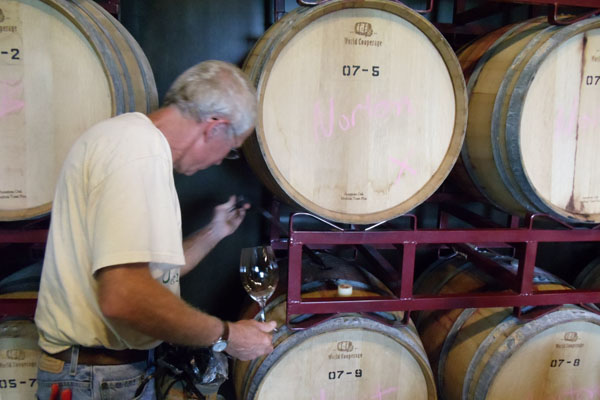
The American wine industry is constantly speculating on which state will emerge as the 5th most important wine producer, following California, Oregon, Washington, and New York. Iowa is most certainly not in this discussion. The state’s iconic output has been corn, soybeans, pork, and eggs for nearly a century. When asked, the average Iowan will be dumbfounded that the state actually produces wine or will characterize their wines somewhere from mediocre to gut wrenching. The glut of berry wines produced in the Amana Colonies in the 1970s is a common culprit for this perception. “Ten years ago, you went to an Iowa winery and you darn near needed a tetanus shot,” jokes Iowa State University Viticulture Specialist Mike White. “Hobby winemakers got into commercial production and you had all kinds of things growing in the tanks.”
But Iowa’s wines are making rapid progress in quality and notoriety. Essentially non-existent in 1990, the industry has grown to 85 currently licensed wineries and over 400 vineyards with 1,200+ acres. (As of 2008, Minnesota had more vineyards but fewer acres under cultivation.) A 2007 economic impact study gauged the industry at $235 million annually with $28 million directly the result of tourism. Iowa’s wines regularly medal at national cold-climate grape competitions and the industry seems eager to push for higher standards of quality. Renowned enologist Dr. Murli Dharmadhikari at Iowa State is leading the formation of an Iowa Vintners Quality Alliance. His department already offers both sensory and chemical evaluation of wines and he works directly with the vintners to resolve any problems.

The past two decades of growth reveal that Iowa’s wines have considerable potential. Iowa is, after all, a state that knows a thing or two about agriculture, yet the history of Iowa wines is one of continual setbacks. Before Prohibition, Iowa was the 6th largest wine producer in the nation, with commercial vineyards and wineries established before California. The Icarians established a 500-acre vineyard near present day Corning, IA in the late 1800s – though they planted mostly French grapes that were maladjusted to Iowa’s climate. Blistering winters killed off much Iowa fruit production in the early 1900s. Then Prohibition shut down all wine production save for the small amount designated for Communion rituals. When it ended in 1933 almost all vineyards had replanted with the state’s new dominant crop — corn.
New vineyards sprang up intermittently in the following decades, but the death knell came from corn production again with the widespread and indiscriminate use of 2,4-D. The popular herbicide that targets broad-leafed plants, 2,4-D drifted on the Iowa winds decimating grapevines across the state and wiping out by the industry by the 1950s. The comeback came in the ’90s, thanks to the pioneering research of the University of Minnesota and Cornell University in engineering cold-hardy grape varieties. These grapes, Frontenac, La Crescent, and Marquette, are among the most widely grown grapes in Iowa. The state now grows over 40 varieties, a mix of engineered hybrids and native American grapes, the names of which are largely unknown to the average wine drinker.
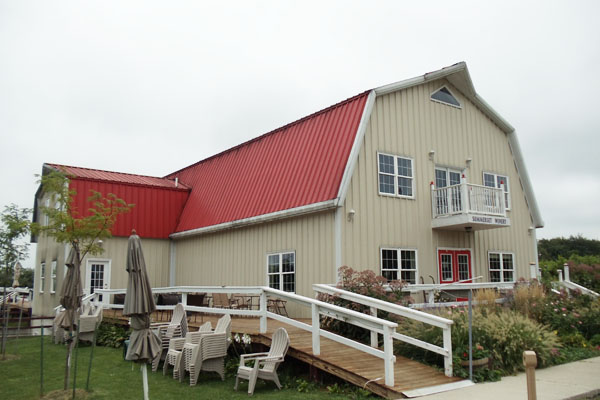
So how do Iowa wines taste? Iowa’s vintners will be the first to tell you that they have a long way to go. “There is a lot of wine being made in Iowa, and probably Minnesota, that’s just very average,” says Paul Groben of Jasper Winery in Des Moines (top). He cites the wrong grapes being grown on the wrong plots as partially to blame, but also speaks favorably on the progress that the state’s wines have made, especially the dry ones. “A dry wine has to be pretty honest. And we can do it, we’re proud of it.” Jasper’s Norton, a grape that’s most popularly grown in Missouri, has an incredible depth of peppery, Syrah-like flavor with great aromas of cinnamon and molasses. A barrel sample of their Noiret revealed a wonderful herbal / hay aroma in a silky smooth body.
Another dry Iowa red not to be missed is the Frontenac from Summerset Winery in Indianola. It won best dry red at the 2010 Mid-American Wine Competition — besting over 500 reds from 16 states. Its lush and velvety black cherry profile would be phenomenal alongside a thick Iowa pork chop. The state’s dry white wines are, like Groben says, average. For the most part, they’re simple and fruity. They would stack up comparably against your favorite $10 Pinot Grigio and Chardonnay.

However, it seems that for every good Iowa wine, there are two that remind you why the negative perception remains. Hybrid grapes generally have more fruit flavors and less tannin than French grapes. It’s truly a different style, but consumers used to drinking earthy, restrained French-style wines could find them tasting cheap in comparison. It seems that poorer cold-climate wines tend to taste manufactured or artificial. The bad sweet reds taste thin like alcoholic Kool-Aid, and they’re often made with much maligned grapes like Catawba and Concord. The poorer whites taste tinny and the sweeter ones taste like there’s added saccharine.
The large proportion of sweet wines produced in Iowa is, paradoxically, contributing to that negative perception and keeping the industry afloat. “Oh yeah, people say ‘Iowa wine, it’s all sweet and it’s made out of rhubarb or dandelions,'” says Dennis Ver Mulm, who runs the marketing and PR website for the Iowa Wine Growers Association. Sweet reds are especially ubiquitous in the state, and there may be no less respected class of wines by those “in the know.” They remain, however, extremely popular. “Between 75 and 80 percent of the wine market nationwide is sweet,” says White. “If you open a winery and produce only dry wines, you’ll have no cash flow.” Ron Mark, owner of Summerset Winery, says the sweet wine market in Iowa is probably even larger. “My Caba Moch [a sweet Rosé blend of Catawba and Marechal Foch] outsells Kendall-Jackson in Des Moines — about 40,000 bottles a year. You don’t argue with that. If Iowa makes them, it’s because they sell. It’s the bottom line.”
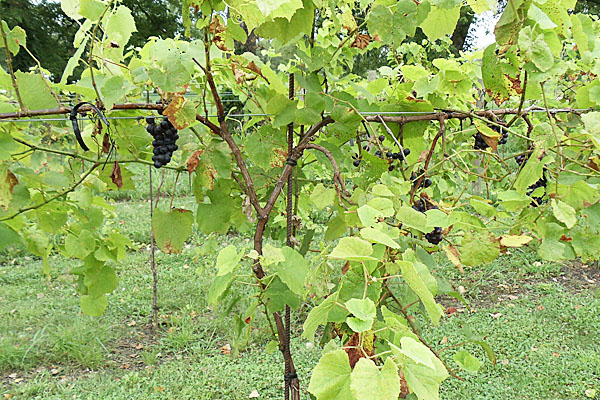
But even with small pockets of popularity, and such demonstrated recent advancement and potential, Iowa wine is still largely off the radar of the average Iowan. “If there’s a fault that Iowans have, it’s that we sometimes undersell ourselves,” says Ver Mulm. “Iowa wineries in total have less than 5 percent of the market for wines consumed by Iowans. But the biggest competition isn’t the winery down the road, or wineries in California, it’s the Iowan who doesn’t drink wine. And I’d rather that be my competition than trying to eat someone else’s lunch.” Those in the industry seem excited to have a largely untapped market with an already strong locavore movement. “I think people are getting proud of it,” says grape-grower Janet Adams. “What seems to be happening, especially in the smaller towns, is wine tasting nights. We’re in Webster City, population about 8,500, and HyVee has a local wine tasting night, third Tuesday of every month, and it’s packed.”
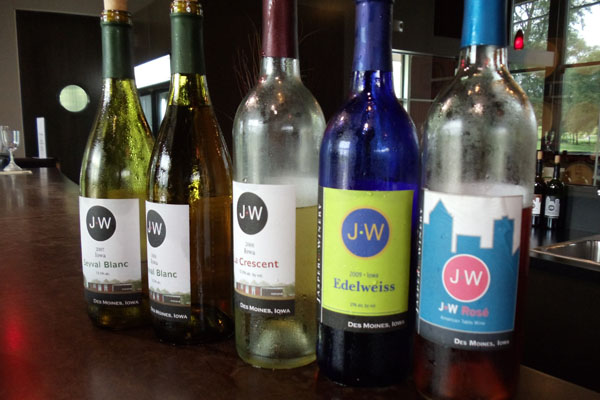
Most importantly, everyone involved with Iowa wine seems bent on constant improvement. They all applaud the creation of the Quality Alliance and see chemical analysis as an integral component for future success. ISU’s White suggests numerous items for improvement: more mechanical harvesters and cold-storage facilities, as well a juice storage facility in the Midwest so vintners don’t have to go through East Coast juice brokers when their tanks empty in February or March. Much juice currently comes from New York’s Finger Lakes region that grows the same cold-climate grapes. Having that kind of facility in the Midwest would expand the market for local grape growers and permit more continuous production from vintners, while keeping the money spent in the region.
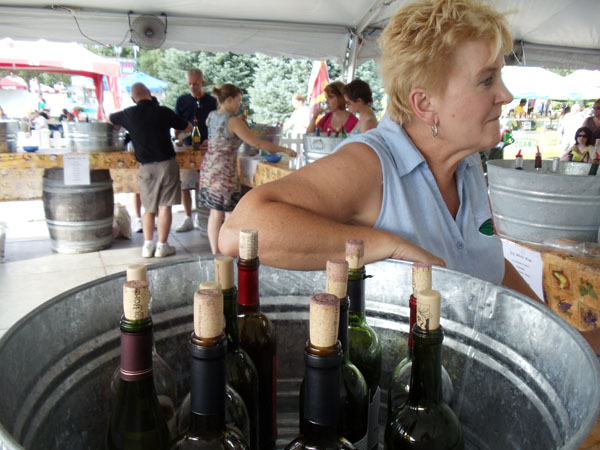
One of the industry’s biggest hurdles is knowing how to let drinkers know exactly what’s in the bottle. “We have to get people to recognize the grape names,” says Summerset’s Mark. “They walk into restaurant and are used to ordering a Chardonnay or Merlot. They look through a wine list and have no idea what a Seyval is, or Vidal Blanc or Frontenac. It could be the best wine in the world, but they won’t know it.” Vintners often pour at restaurants, organizing flights of Iowa wines with notes on common flavors and sweetness level, putting each grape into perspective. Many cold-climate grapes are already marketed against what consumers know –- Norton and Vignoles are commonly referred to as the Cabernet and Riesling of the Midwest, respectively. The challenge lies in likening the wines to similar, more well-known ones while preparing consumers to expect something a little different.
The message from everyone in the industry is that the wine is really secondary to the experience at the winery. Iowa wineries have mostly free tasting rooms, set on beautiful tracts of land that seem miles away from the cities they inhabit, with almost every wine sold under $20. “In Iowa, we don’t make wine to make money,” says Katie Bradshaw of Jasper Winery, “we make it to share with our friends and neighbors. It’s fun; we do it because we love it.” Many Iowa wineries host all kinds of gatherings — concert series, weddings and showers, even bocce leagues on their grounds. “I like to say that the mother of the bride pays my rent,” says Mark. Many new wineries are being built with event hosting predominantly in mind.
Iowa’s wines are much like Iowans themselves – approachable, humble, and straightforward. Some wines are very good, but most won’t knock your socks off, and their quality varies widely. Their charm lies in the people that produce them in an area you wouldn’t expect – and the winery experience does make all the difference. Looking out over vineyards with a glass of Seyval on a cloudless Iowa Saturday, I couldn’t help but recall that famous Iowa movie line: “Oh, people will come, Ray. People will most definitely come.”
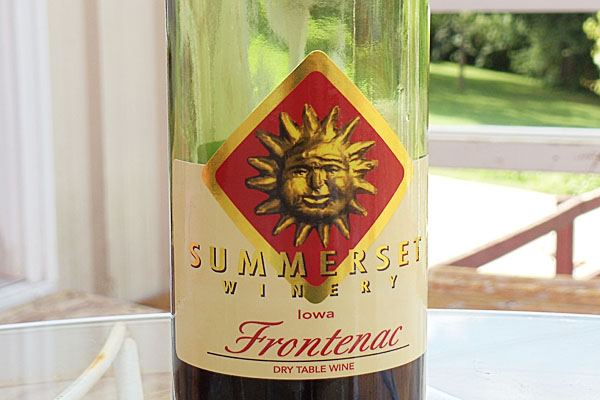

Great article with a fair description of lots of great (and still becoming great) regional wines!
Thanks for the article. A followup with more details on specific wines and wineries would be awesome. Which ones are worth the trek? I’m looking forward to exploring some of the Iowa wineries when I head down in October.
I believe that deep, rich Iowa soils have the capacity to produce wines like nowhere else in the world. I would personally like to see peoprieary vararietals, bred for our specific climate and soils, and that every grower engage in at least a hobby level grapebreeding program.
Thanks so much for the excellent article. I’m in Iowa for a week and looking for wineries to visit, but I couldn’t find any clear information on the Iowa Wineries website about what Iowa is known for; what they are trying to accomplish, signature grapes, etc. Your article provided all of this very helpful information.